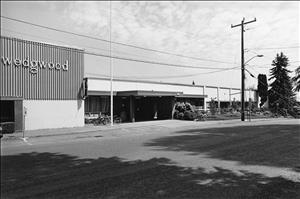This history of Wedgwood Elementary School is taken from the second edition of Building for Learning: Seattle Public School Histories, which includes histories of every school building used by the district since its formation around 1862. The original essay was written for the 2002 first edition by Nile Thompson and Carolyn J. Marr, and updated for the 2024 edition by HistoryLink contributor Ryan Anthony Donaldson.
Wedgwood Neighborhood
The neighborhood now called Wedgwood was first settled around 1900 by Charles Thorpe, who grew ginseng there after learning of its medicinal properties while in China. In the 1920s, Seattle University purchased the area, which it was considering for a campus location. The university sold the land in the 1940s to developer Albert Balch, who built homes in the area. Because his wife was dissatisfied with his earlier naming of the View Ridge neighborhood, he suggested that she pick a name for the new development. She chose the name because of her fondness for Wedgwood china.
The post-World War II movement to the suburbs, spurred by economic prosperity and population growth, meant that neighborhoods like Wedgwood were increasingly popular. The new houses boasted wide lots and all the modern conveniences. Large trees and the lack of city noise and traffic gave the area a country atmosphere.
In 1952, Wedgwood clearly needed a school, considering the overcrowded conditions at Ravenna, View Ridge, and Bryant. The school district selected a former cherry and apple orchard for the school site. As a short-term solution to the crowded conditions at nearby schools, a 16-portable school was opened there in 1953 (now NE 85th and 27th Avenue NE). Twelve classrooms housing 400 children grades K-5 opened three weeks into the fall semester. The 6th grade was added the following year. In 1954-1955, 14 classes were housed in 12 portables by double-shifting four classes.
Because of construction delays, the new building was not ready in April 1955 as expected. It opened dramatically in early June with only half a month remaining in the school year. Many of the pupils brought wagons from home to transport their possessions and books as they moved from the portables to the permanent building. The students especially appreciated the auditorium-lunchroom and gymnasium.
The next fall, about 140 pupils were added from Maple Leaf and a few from Ravenna. Enrollment peaked in 1957-1958 with 897 students. After graduation, students went to Eckstein or Addams for junior high.
As part of the district’s desegregation program, Wedgwood formed a triad with Leschi and Decatur. Wedgwood and Decatur became K-3, and Leschi housed K, 4-5 from 1978 to 1988. Building improvements in the 1980s included special education program modifications in 1983 and a pressure glue tuckpoint chimney in 1984.
In 2009, a group of Wedgwood 4th and 5th graders emailed legislators and visited the State Capitol to successfully lobby a state bill (SB-5071) recognizing the Olympic Marmot as Washington State’s endemic mammal. To recognize the group's achievement, students voted to change Wedgwood’s mascot from Pepe the Dolphin to Marty the Marmot. Today, Wedgwood is home to the Mighty Marmots.
History
Wedgwood Elementary School
Location: 2720 NE 85th Street
Building: 22-room reinforced concrete
Architect: John Graham & Co.
Site: 4.48 acres
1954: Named on April 16
1955: Opened on June 1
1989: Transitioned to K-5
2005: Library upgrade
Wedgwood Elementary School in 2023
Enrollment: 411 (2020)
Address: 2720 NE 85th Street
Nickname: Mighty Marmots
Configuration: K-5
Color: Wedgwood blue

